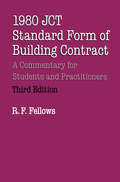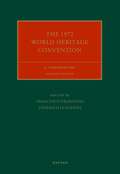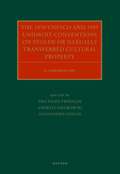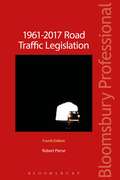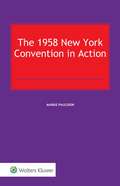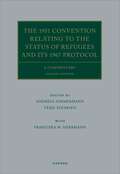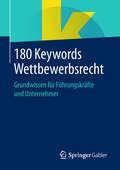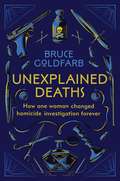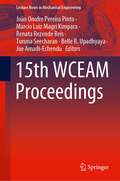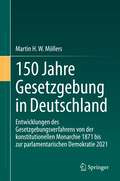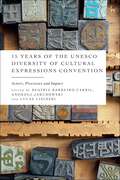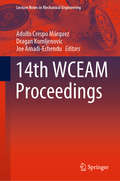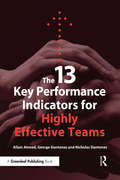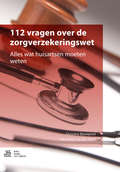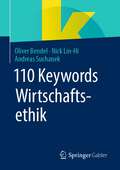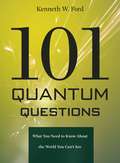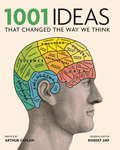- Table View
- List View
1980 JCT Standard Form of Building Contract: A Commentary for Students and Practitioners (Building and Surveying Series)
by Richard FellowsThis book analyses and comments on the 1980 JCT Standard Form of Building Contract, Private with Quantities Edition on a clause-by-clause basis, including notes on interpretation, legal precedents and information on the alternative editions of the Standard Form as well as the appropriate supplements. The third edition of this book incorporates the amendments published up to the end of November 1994 and updates the case law to include significant, recent precedents which supplement those included in the first two editions. Thus, this book will prove of use to many concerned with building, whether in industry or the professions commonly encountering problems of interpretation and implementation of the contract, or as students. The use of this book is recommended to be in conjunction with a copy of the appropriate JCT contract in order that the exact terminology of the document may be studied together with its interpretation. This is particularly important in practical situations where amendments to the contract vary the standard terms.
The 1972 World Heritage Convention: A Commentary (Oxford Commentaries on International Cultural Heritage Law)
by Prof Francesco Francioni Prof Federico LenzeriniAlmost fifty years have passed since the adoption of the Convention Concerning the Protection of the World Cultural and Natural Heritage (the UNESCO World Heritage Convention). With its 194 States Parties, it is the most widely ratified convention within the family of UNESCO treaties on the protection of cultural heritage. The success of this Convention and its almost universal acceptance by the international community of states is due to the great appeal that recognising certain properties as “world heritage” has for national governments. Since the publication of the first Commentary, new problems have arisen in the management of world heritage sites. It has become increasingly difficult to properly monitor the conservation of the ever-growing mass of sites inscribed in the World Heritage List, and to resolve disputes over the formal designation of contested world heritage properties - a problem that has led to the withdrawal of the United States and Israel from UNESCO. New frontiers are now being explored for the expansion of the world heritage idea over marine areas beyond national jurisdiction, and the monopoly of the State in the identification, delineation, and presentation of world heritage properties is being increasingly challenged in the name of indigenous peoples' rights and by local communities claiming ownership over contested cultural sites. At the same time, the regime of world heritage protection has infiltrated other areas of international law, especially international economic law, investment arbitration, and the area of international criminal law. This second edition critically examines the World Heritage Convention against this dynamic evolution of international heritage law to help academics, lawyers, diplomats, and officials interpret and apply the norms of the Convention after half a century of uninterrupted implementing practice by State Parties and Treaty Bodies.
The 1972 World Heritage Convention: A Commentary (Oxford Commentaries on International Cultural Heritage Law)
by Prof Francesco Francioni Prof Federico LenzeriniAlmost fifty years have passed since the adoption of the Convention Concerning the Protection of the World Cultural and Natural Heritage (the UNESCO World Heritage Convention). With its 194 States Parties, it is the most widely ratified convention within the family of UNESCO treaties on the protection of cultural heritage. The success of this Convention and its almost universal acceptance by the international community of states is due to the great appeal that recognising certain properties as “world heritage” has for national governments. Since the publication of the first Commentary, new problems have arisen in the management of world heritage sites. It has become increasingly difficult to properly monitor the conservation of the ever-growing mass of sites inscribed in the World Heritage List, and to resolve disputes over the formal designation of contested world heritage properties - a problem that has led to the withdrawal of the United States and Israel from UNESCO. New frontiers are now being explored for the expansion of the world heritage idea over marine areas beyond national jurisdiction, and the monopoly of the State in the identification, delineation, and presentation of world heritage properties is being increasingly challenged in the name of indigenous peoples' rights and by local communities claiming ownership over contested cultural sites. At the same time, the regime of world heritage protection has infiltrated other areas of international law, especially international economic law, investment arbitration, and the area of international criminal law. This second edition critically examines the World Heritage Convention against this dynamic evolution of international heritage law to help academics, lawyers, diplomats, and officials interpret and apply the norms of the Convention after half a century of uninterrupted implementing practice by State Parties and Treaty Bodies.
The 1970 UNESCO and 1995 UNIDROIT Conventions on Stolen or Illegally Transferred Cultural Property: A Commentary (Oxford Commentaries on International Cultural Heritage Law)
by Ana Filipa Vrdoljak Andrzej Jakubowski Alessandro ChechiThe illicit traffic in cultural objects is a grave concern to the general public and international community. The resulting cultural damage fuels debates on how best to regulate the trade in cultural objects and inform legal responses at all levels for the protection of movable cultural heritage. Treaties concerning the treatment of cultural objects during peacetime and war represent some of the earliest multilateral initiatives on cultural heritage in the modern era. They also remain some of the most deeply contested, representing shifting fault lines within the international community. Authored by leading scholars and practitioners from around the world, this Commentary is the first to cover the two leading multilateral treaties on movable cultural heritage in one volume: the Convention on the Means of Prohibiting and Preventing the Illicit Import, Export and Transfer of Ownership of Cultural Property adopted by UNESCO in 1970 and the Convention on Stolen or Illegally Exported Cultural Objects adopted by UNIDROIT in 1995. This Commentary is designed to be the authoritative text for academics, lawyers, policymakers, and diplomats on the protection and regulation of cultural objects. Encompassing both public and private international law rules on the trade in cultural objects, it provides a detailed historical and thematic overview. Drawing on the travaux preparatoires and intergovernmental and state practice over the last half century, the Commentary provides an article-by-article analysis of the interpretation and application of these treaties. The texts 1970 UNESCO and 1995 UNIDROIT Conventions are examined in the working context of other culture conventions including the World Heritage Convention and the Intangible Heritage Convention, as well as related fields of international law, such as international humanitarian law, international criminal law, human rights law, and international economic law. The volume also offers a critical examination of current trends and future directions which are informing the field.
The 1970 UNESCO and 1995 UNIDROIT Conventions on Stolen or Illegally Transferred Cultural Property: A Commentary (Oxford Commentaries on International Cultural Heritage Law)
by Ana Filipa Vrdoljak Andrzej Jakubowski Alessandro ChechiThe illicit traffic in cultural objects is a grave concern to the general public and international community. The resulting cultural damage fuels debates on how best to regulate the trade in cultural objects and inform legal responses at all levels for the protection of movable cultural heritage. Treaties concerning the treatment of cultural objects during peacetime and war represent some of the earliest multilateral initiatives on cultural heritage in the modern era. They also remain some of the most deeply contested, representing shifting fault lines within the international community. Authored by leading scholars and practitioners from around the world, this Commentary is the first to cover the two leading multilateral treaties on movable cultural heritage in one volume: the Convention on the Means of Prohibiting and Preventing the Illicit Import, Export and Transfer of Ownership of Cultural Property adopted by UNESCO in 1970 and the Convention on Stolen or Illegally Exported Cultural Objects adopted by UNIDROIT in 1995. This Commentary is designed to be the authoritative text for academics, lawyers, policymakers, and diplomats on the protection and regulation of cultural objects. Encompassing both public and private international law rules on the trade in cultural objects, it provides a detailed historical and thematic overview. Drawing on the travaux preparatoires and intergovernmental and state practice over the last half century, the Commentary provides an article-by-article analysis of the interpretation and application of these treaties. The texts 1970 UNESCO and 1995 UNIDROIT Conventions are examined in the working context of other culture conventions including the World Heritage Convention and the Intangible Heritage Convention, as well as related fields of international law, such as international humanitarian law, international criminal law, human rights law, and international economic law. The volume also offers a critical examination of current trends and future directions which are informing the field.
1961-2017 Road Traffic Legislation: Annotated Legislation
by Robert Pierse1961-2017 Road Traffic Legislation sets out annotated road traffic legislation from 1961 to 2017 and covers all relevant case law and Statutory Instruments. Includes reference to litigation on intoxicants, dangerous driving and other areas of Road Traffic Law. This title covers both practice and procedure and each section is annotated fully and cross referenced.Road traffic law is a vital part of many smaller solicitors' firms' daily work and this title provides them with annotated legislation in an area rife with difficulty as the legislation is piecemeal and often contradictory. Many Statutory Instruments and Acts are created in this area: some enacted in full, others not. This book updates the practitioner on this thorny area of law and points them to relevant case law where necessary.
The 1958 New York Convention in Action
by Marike PaulssonThe 1958 New York Convention has been called the most effective instance of international legislation in the entire history of commercial law. However, the succinct text of the Convention leaves open a host of significant and complex questions, which may be, and have been, answered in a variety of ways; as difficult cases arise and demand solutions, they generate inconsistent outcomes. For all its remarkable success, the Convention has on occasion proved itself to be unreliable and unpredictable. This book simultaneously exposes the difficulties of the Convention and explores potential solutions. It examines each substantive article of the New York Convention in accordance with the following outline: • the text and its issues; • original intent; • the prism of the rules of interpretation of the Vienna Convention; • judicial outcomes; and • appraisal. By drawing on the Convention's drafting history in great detail, the book presents a coherent account of how the most frequently recurring interrogations about the text are reflected (or not) in judicial practice. The author studied more than 1,700 decisions rendered under the Convention since its inception in 1958 in order to provide a succinct selection of landmark cases per article. With its intense investigation of the complex reality underlying contracting States' commitment in principle and judicial application in fact, the author's judicial understanding of the Convention provides a clear conceptual framework that will help avoid outcomes at odds with the purposes of this important instrument. Lawyers and judges will rely on this book not only to situate the Convention in the national legal orders where it is intended to produce its effects, but also discover practical ways to respond to distinct questions of application.
The 1951 Convention Relating to the Status of Refugees and its 1967 Protocol 2e (Oxford Commentaries on International Law)
by Andreas Zimmermann Terje Einarsen Franziska HerrmannThe Convention Relating to the Status of Refugees adopted on 28 July 1951 in Geneva continues to provide the most comprehensive codification of the rights of refugees yet attempted. Consolidating previous international instruments relating to refugees, the 1951 Convention with its 1967 Protocol marks a cornerstone in the development of international refugee law. At present, there are 149 States Parties to one or both of these instruments, expressing a worldwide consensus on the definition of the term refugee and the fundamental rights to be granted to refugees. These facts demonstrate and underline the extraordinary significance of these instruments as the indispensable legal basis of international refugee law. This Commentary provides for a systematic and comprehensive analysis of the 1951 Convention and the 1967 Protocol on an article-by-article basis, exposing the interrelationship between the different articles and discussing the latest developments in international refugee law. In addition, several thematic contributions analyse questions of international refugee law which are of general significance, such as regional developments, the interrelationship between refugee law and general human rights law, as well as the relationship between refugee law and the law of the sea.
The 1951 Convention Relating to the Status of Refugees and its 1967 Protocol 2e (Oxford Commentaries on International Law)
by Andreas Zimmermann Terje Einarsen Franziska M. HerrmannThe Convention Relating to the Status of Refugees adopted on 28 July 1951 in Geneva continues to provide the most comprehensive codification of the rights of refugees yet attempted. Consolidating previous international instruments relating to refugees, the 1951 Convention with its 1967 Protocol marks a cornerstone in the development of international refugee law. At present, there are 149 States Parties to one or both of these instruments, expressing a worldwide consensus on the definition of the term refugee and the fundamental rights to be granted to refugees. These facts demonstrate and underline the extraordinary significance of these instruments as the indispensable legal basis of international refugee law. This Commentary provides for a systematic and comprehensive analysis of the 1951 Convention and the 1967 Protocol on an article-by-article basis, exposing the interrelationship between the different articles and discussing the latest developments in international refugee law. In addition, several thematic contributions analyse questions of international refugee law which are of general significance, such as regional developments, the interrelationship between refugee law and general human rights law, as well as the relationship between refugee law and the law of the sea.
The 1951 Convention Relating to the Status of Refugees and its 1967 Protocol 2e (Oxford Commentaries on International Law)
by Andreas Zimmermann Terje Einarsen Franziska M. HerrmannThe Convention Relating to the Status of Refugees adopted on 28 July 1951 in Geneva continues to provide the most comprehensive codification of the rights of refugees yet attempted. Consolidating previous international instruments relating to refugees, the 1951 Convention with its 1967 Protocol marks a cornerstone in the development of international refugee law. At present, there are 149 States Parties to one or both of these instruments, expressing a worldwide consensus on the definition of the term refugee and the fundamental rights to be granted to refugees. These facts demonstrate and underline the extraordinary significance of these instruments as the indispensable legal basis of international refugee law. This Commentary provides for a systematic and comprehensive analysis of the 1951 Convention and the 1967 Protocol on an article-by-article basis, exposing the interrelationship between the different articles and discussing the latest developments in international refugee law. In addition, several thematic contributions analyse questions of international refugee law which are of general significance, such as regional developments, the interrelationship between refugee law and general human rights law, as well as the relationship between refugee law and the law of the sea.
180 Keywords Wettbewerbsrecht: Grundwissen für Führungskräfte und Unternehmer
by Springer Fachmedien WiesbadenVon Absatzbindung über Neo-Schumpeter-Hypothesen bis Zollkartell: Die Sprache des Wettbewerbsrechts kennt unzählige Fachtermini. Einen ersten schnellen Überblick verschafft das vorliegende Nachschlagewerk, das anhand von 180 Schlüsselbegriffen die Grundlagen erläutert. Die Erklärungen sind kompakt und verständlich formuliert und bieten somit Basiswissen für alle, die einen schnellen Einstieg in die Praxis suchen, sich für das Wettbewerbsrecht interessieren oder ihr vorhandenes Wissen auffrischen wollen.
18 Tiny Deaths: The Untold Story of Frances Glessner Lee and the Invention of Modern Forensics
by Bruce GoldfarbFor most of human history, sudden and unexpected deaths of a suspicious nature, when they were investigated at all, were examined by lay persons without any formal training. People often got away with murder. Modern forensic investigation originates with Frances Glessner Lee - a pivotal figure in police science.Frances Glessner Lee (1878-1962), born a socialite to a wealthy and influential Chicago family, was never meant to have a career, let alone one steeped in death and depravity. Yet she became the mother of modern forensics and was instrumental in elevating homicide investigation to a scientific discipline. Frances Glessner Lee learned forensic science under the tutelage of pioneering medical examiner Magrath - he told her about his cases, gave her access to the autopsy room to observe post-mortems and taught her about poisons and patterns of injury. A voracious reader too, Lee acquired and read books on criminology and forensic science - eventually establishing the largest library of legal medicine. Lee went on to create The Nutshell Studies of Unexplained Death - a series of dollhouse-sized crime scene dioramas depicting the facts of actual cases in exquisitely detailed miniature - and perhaps the thing she is most famous for. Celebrated by artists, miniaturists and scientists, the Nutshell Studies are a singularly unusual collection. They were first used as a teaching tool in homicide seminars at Harvard Medical School in the 1930s, and then in 1945 the homicide seminar for police detectives that is the longest-running and still the highest-regarded training of its kind in America. Both of which were established by the pioneering Lee.In 18 Tiny Deaths, Bruce Goldfarb weaves Lee's remarkable story with the advances in forensics made in her lifetime to tell the tale of the birth of modern forensics.
15th WCEAM Proceedings (Lecture Notes in Mechanical Engineering)
by João Onofre Pereira Pinto Marcio Luiz Magri Kimpara Renata Rezende Reis Turuna Seecharan Belle R. Upadhyaya Joe Amadi-EchenduThis book gathers selected peer-reviewed papers from the 15th World Congress on Engineering Asset Management (WCEAM), which was hosted by The Federal University of Mato Grosso do Sul Campo Grande, Brazil, from 15–-18 August 2021This book covers a wide range of topics in engineering asset management, including: strategy and standards;sustainability and resiliency;servitisation and Industry 4.0 business models;asset information systems; andasset management decision-making. The breadth and depth of these state-of-the-art, comprehensive proceedings make them an excellent resource for asset management practitioners, researchers, and academics, as well as undergraduate and postgraduate students.
150 Jahre Gesetzgebung in Deutschland: Entwicklungen des Gesetzgebungsverfahrens von der konstitutionellen Monarchie 1871 bis zur parlamentarischen Demokratie 2021
by Martin H. MöllersDieses Buch erläutert die verfassungsmäßige Ausgestaltung der Gesetzgebungsverfahren im Kaiserreich, in der Weimarer Republik und in der Bundesrepublik Deutschland im Zusammenhang. Dadurch wird nachvollziehbar, dass die Gesetzgebung der heutigen parlamentarischen Demokratie ihre Basis bereits in der konstitutionellen Monarchie des Deutschen Kaiserreichs vor 150 Jahren hat. Obwohl das Verfahren der Gesetzgebung im Kaiserreich vordemokratisch ausgestaltet war, sind ihre wesentlichen Merkmale bis heute unverändert. Welche Änderungen die Gesetzgebungsverfahren von Verfassung zu Verfassung im Einzelnen erfuhren, analysiert das Buch und stellt heraus, dass diese Änderungen vor allem das Bund-Länder-Verhältnis, die Volkssouveränität sowie den Einfluss der Grundrechte auf die Gesetzgebung betrafen. Dabei kommen auch Auffassungen der Staatsrechtslehre früherer Zeiten zur Rechtsstaatlichkeit zur Sprache, die immer noch zum derzeitigen Meinungsspektrum zählen, heute jedoch nicht mehr zu halten sind. Zudem dokumentiert das Buch, wer an den Gesetzgebungsverfahren offiziell und wer faktisch beteiligt war bzw. noch ist und welche politischen Einflussnahmen auf die Gesetzgebung im Lauf der Geschichte festzustellen sind. So wird u.a. dokumentiert, dass insbesondere der Mangel an Transparenz der Zusammenarbeit von Exekutive und Legislative mit Lobbyisten dazu führt, dass viele Gesetze einzelne Bevölkerungsgruppen oder Wirtschaftszweige bevorzugen.
15 Years of the UNESCO Diversity of Cultural Expressions Convention: Actors, Processes and Impact
by Beatriz Barreiro Carril, Andrzej Jakubowski and Lucas LixinskiThis book queries, through the prism of the Convention for the Protection and the Promotion of the Diversity of Cultural Expressions (the Convention), the ways in which the processes and substance of international law-making have shifted in response to new technologies and new actors. The essays, written by recognised experts in the field, engage deeply with the practice under the Convention. The 4 parts examine: the rise of new actors and their impact on the Convention's law-making and implementation; the specific implementation of Article 21; the role of cultural communities in promoting diversity of cultural expressions; and the effectiveness and coherence of the Convention. Scholars and practitioners in the field of international law of culture and international cultural cooperation will welcome this fascinating new book.
15 Years of the UNESCO Diversity of Cultural Expressions Convention: Actors, Processes and Impact
This book queries, through the prism of the Convention for the Protection and the Promotion of the Diversity of Cultural Expressions (the Convention), the ways in which the processes and substance of international law-making have shifted in response to new technologies and new actors. The essays, written by recognised experts in the field, engage deeply with the practice under the Convention. The 4 parts examine: the rise of new actors and their impact on the Convention's law-making and implementation; the specific implementation of Article 21; the role of cultural communities in promoting diversity of cultural expressions; and the effectiveness and coherence of the Convention. Scholars and practitioners in the field of international law of culture and international cultural cooperation will welcome this fascinating new book.
14th WCEAM Proceedings (Lecture Notes in Mechanical Engineering)
by Adolfo Crespo Márquez Dragan Komljenovic Joe Amadi-EchenduThis book gathers selected peer-reviewed papers from the 14th World Congress on Engineering Asset Management (WCEAM), which was held in Singapore on 28–31 July 2019, as well as papers presented during the 1st WCEAMOnline event which focused on the ramifications of Covid-19 on infrastructure systems.This book covers a wide range of topics in engineering asset management, including:asset management services provisioning;servitization;decision-making;asset management systems;industrial Internet of things; andvulnerability and resilience of infrastructure systems. The breadth and depth of these state-of-the-art, comprehensive proceedings make them an excellent resource for asset management practitioners, researchers and academics, as well as undergraduate and postgraduate students.
The 13 Key Performance Indicators for Highly Effective Teams
by Allam Ahmed George Siantonas Nicholas SiantonasAn organisation's most important asset is its people. And critical to an organisation's success is the extent to which its people interact effectively – both with each other as team members and with the wider organisation. This is why managing teams has become a key area for a growing number of organisations around the world. While many organisations are world-class at managing their materials and machinery, they fall short in managing the human side of their activities.This book outlines the challenges faced by both team leaders and team members in 21st-century workplaces. It proposes 13 key performance or "team health" indicators for highly effective teams based on research data collected from a large range of industry sectors, team sizes and organisations in the UK. It contributes to the understanding of the nature and functioning of team cohesiveness by describing teamwork as a multi-component variable and identifying the factors that impact on teams and the implications of teamwork for organisations.The book sets out to aid organisations by introducing a Team Performance Diagnostic (TPD) tool. The TPD enables organisations to gain an accurate and detailed insight into the real-time performance of their teams, helps team managers to understand the underlying 'people' issues within the team and how to reach higher levels of team performance quickly. The TPD has been widely used in major multinationals and the UK public sector to pinpoint hard-to-find opportunities to achieve rapid improvements.The research suggests that the use of TPD contributes to more free-flowing feedback both within the team and in the organisation as a whole, and that successful teams are indicative of a healthy organisational culture.This book is an essential guide for senior managers and policy-makers dealing with team effectiveness, and will be highly useful for students of business and management.
The 13 Key Performance Indicators for Highly Effective Teams
by Allam Ahmed George Siantonas Nicholas SiantonasAn organisation's most important asset is its people. And critical to an organisation's success is the extent to which its people interact effectively – both with each other as team members and with the wider organisation. This is why managing teams has become a key area for a growing number of organisations around the world. While many organisations are world-class at managing their materials and machinery, they fall short in managing the human side of their activities.This book outlines the challenges faced by both team leaders and team members in 21st-century workplaces. It proposes 13 key performance or "team health" indicators for highly effective teams based on research data collected from a large range of industry sectors, team sizes and organisations in the UK. It contributes to the understanding of the nature and functioning of team cohesiveness by describing teamwork as a multi-component variable and identifying the factors that impact on teams and the implications of teamwork for organisations.The book sets out to aid organisations by introducing a Team Performance Diagnostic (TPD) tool. The TPD enables organisations to gain an accurate and detailed insight into the real-time performance of their teams, helps team managers to understand the underlying 'people' issues within the team and how to reach higher levels of team performance quickly. The TPD has been widely used in major multinationals and the UK public sector to pinpoint hard-to-find opportunities to achieve rapid improvements.The research suggests that the use of TPD contributes to more free-flowing feedback both within the team and in the organisation as a whole, and that successful teams are indicative of a healthy organisational culture.This book is an essential guide for senior managers and policy-makers dealing with team effectiveness, and will be highly useful for students of business and management.
12 Months to Live: A knock-out new series from James Patterson (Jane Smith #1)
by James Patterson'The phenomenal Patterson, one of the great storytellers of our time, does not often produce a new character, but he does here to stunning effect' Daily Mail'A gutsy heroine. A ticking clock. A breathless pace. Wow! This one had me reeling' JANE CORRY'Compelling' Crime Monthly_____________________Her name is Jane Smith. But to friends and foes, she's Jane Effing Smith.Why? Because she's the best criminal defence attorney in the Hamptons - the elite world of New York's rich and infamous. Because she's as good an investigator as she is a lawyer. Because she's tough. She's strong.As Jane is preparing to defend a high-profile client accused of a triple homicide, she's also hired to revive a cold case - a cluster of unsolved murders.Then another bombshell lands. A devastating medical diagnosis. Terminal. She's got a year to live.But for now, she has a trial to win. Unless one of her many enemies kills her first.____________________________Readers are loving 12 Months to Live!'You are going to love Jane Smith! She is a fantastic new character from one of my favourite authors''Wow what a book! I could not put it down''I loved it from start to finish''A fast, easy to read, enjoyable and entertaining read''Punchy, fast-paced and totally absorbing'________________________________PRAISE FOR JAMES PATTERSON'The master storyteller of our times' HILLARY RODHAM CLINTON'It's no mystery why James Patterson is the world's most popular thriller writer ... Simply put: nobody does it better.' JEFFERY DEAVER'No one gets this big without amazing natural storytelling talent - which is what Jim has, in spades.' LEE CHILD'Patterson boils a scene down to the single, telling detail, the element that defines a character or moves a plot along. It's what fires off the movie projector in the reader's mind.' MICHAEL CONNELLY'James Patterson is The Boss. End of.' IAN RANKIN'One of the greatest storytellers of all time' PATRICIA CORNWELL'Patterson knows where our deepest fears are buried ... there's no stopping his imagination' NEW YORK TIMES BOOK REVIEW'Patterson is in a class by himself' GUARDIAN
112 vragen over de zorgverzekeringswet: Alles wat huisartsen moeten weten
by Christine Beerepoot Henriëtte van der HorstDit boek geeft antwoord op de meest gestelde vragen rondom de zorgverzekeringswet in de huisartsenpraktijk. Het gaat in op de laatste ontwikkelingen in de wet- en regelgeving.De vragen over de zorgverzekering worden vaak in de huisartsenpraktijk gesteld. Ondanks de goede inburgering van de zorgverzekering in Nederland. Omdat de huisarts het eerste aanspreekpunt is voor vragen over gezondheid en ziekte. Vragen zoals:Welke zorg valt onder het basispakket?Wat gebeurt er als de nominale premie niet wordt betaald?Wat is de hoogte van het verplicht eigen risico?Valt huisartsenzorg of medisch specialistische zorg onder het verplicht eigen risico?Maar ook meer complexe vragen over geschillen en bevoegde instanties en de regeling voor gemoedsbezwaarden komen aan bod.Jaarlijks vinden er aanpassingen en verbeteringen plaats in de zorgverzekering. Denk daarbij aan de wijzigingen in het basispakket of indexering van eigen betalingen of het eigen risico.In 2015 is de stelselwijziging van de langdurige zorg ingevoerd. Dit heeft geleid tot pakketwijzigingen in de zorgverzekering. De nieuwe Wet langdurige zorg is ingevoerd alsmede de Jeugdwet en de Wet maatschappelijke ondersteuning.Ook wordt er uitgebreid stilgestaan bij de actuele ontwikkelingen in de huisartsenpraktijk. Zoals de intrede van de praktijkondersteuners somatiek en GGZ in de huisartsenpraktijk.Daarnaast wordt aandacht besteed aan de vergoedingenstructuur voor de huisarts die sinds 2015 grondig is herzien. Steeds meer asielzoekers of illegalen bezoeken de huisarts. Welke vergoedingen zijn dan van toepassing?112 Vragen over de Zorgverzekeringswet is een praktisch vraag- en antwoordboek voor de huisarts over de zorgverzekeringswet in de huisartsenpraktijk.
110 Keywords Wirtschaftsethik
by Oliver Bendel Nick Lin-Hi Andreas SuchanekVon Aktivist über Nachhaltigkeit bis zu Zensur: Im Kontext der Wirtschaftsethik gibt es unzählige Fachtermini und Abkürzungen. Das vorliegende Nachschlagewerk eignet sich für den ersten schnellen Überblick. In 110 übersichtlichen Schlüsselbegriffen werden die Grundlagen erläutert. Die Erklärungen sind kompakt und verständlich formuliert und bieten Basiswissen für alle, die einen schnellen Einstieg in das Thema Wirtschaftsethik suchen, einzelne Begriffe nachschlagen oder ihr vorhandenes Wissen auffrischen möchten.
101 Quantum Questions: What You Need To Know About The World You Can't See
by Kenneth William FordThis reader-friendly, richly illustrated book provides an engaging overview of quantum physics, from “big ideas” like probability and uncertainty and conservation laws to the behavior of quarks and photons and neutrinos, and on to explanations of how a laser works and why black holes evaporate.
101 Quantum Questions: What You Need To Know About The World You Can't See
by Kenneth William FordThis reader-friendly, richly illustrated book provides an engaging overview of quantum physics, from “big ideas” like probability and uncertainty and conservation laws to the behavior of quarks and photons and neutrinos, and on to explanations of how a laser works and why black holes evaporate.
1001 Ideas that Changed the Way We Think (1001)
by Robert ArpAn awe-inspiring overview of the development of human knowledge over the centuries!Part of the highly successful '1001' series which have sold over a million copies in the UK alone 1001 Ideas That Changed The Way We Think offers not only a comprehensive history of ideas, but also an eminently browsable source of amusement.This richly informative and entertaining book provides a wide variety of answers to those eternal questions such as...How was the universe created and what is the place of humans within it? How should a person live? And how can we build a just society?Readers will discover how the Greek philosopher Zeno 'proved' a flying arrow never moves and the mathematical proof of the existence of life in other galaxies. The inspiring ideas explored range from Gandhi's theory of civil disobedience to Mary Wollstonecraft's groundbreaking advocacy of women's rights. A wide variety of cultural movements are also covered, including Neoclassicism, Surrealism and Postmodernism.Drawing of a wide spectrum of topics including politics, cosmology, the arts, philosophy and religious beliefs, 1001 Ideas That Changed The Way We Thinktraces the exponential growth of human knowledge across the centuries. Ranging from the ancient wisdom of Confucius and Plato, to the cutting-edge theories taking shape in the twenty-first century, this book offers a wealth of stimulation and wit for any reader with a lively and curious mind.
